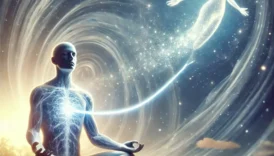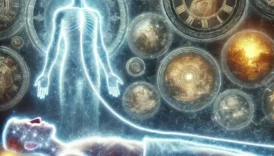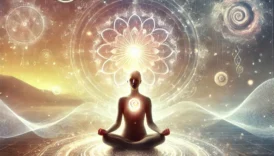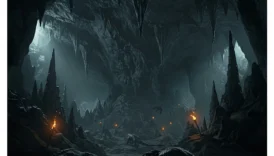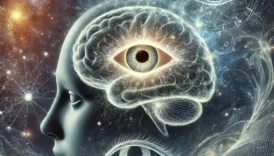Ancient Esoteric Knowledge: Occultism, Alchemy, Secret Societies, and Mysterious Teachings
Ancient esoteric teachings encompass some of the most mysterious and longstanding forms of knowledge in human history. Occultism, alchemy, secret societies, and the wisdom that has been passed down through centuries all trace their roots to humankind’s quest for deeper truths—beyond the tangible and into the realm of the supernatural or spiritual. Often transmitted behind closed doors or restricted to certain initiates, these ancient teachings have long both intrigued and unnerved observers.
Etymologically, “esoteric” comes from the Greek word esōterikos, signifying “internal” or “inner.” This indicates that we’re dealing with specialized knowledge not intended for the general public. From a parapsychological standpoint, these teachings intersect with modern explorations of consciousness and phenomena such as telepathy, clairvoyance, and out-of-body experiences. In this in-depth discussion, we will delve into the core elements of occultism, alchemy, and secret societies, examining how these intersect with parapsychology and exploring their cultural, historical, and philosophical underpinnings.
- Ancient Esoteric Knowledge: Occultism, Alchemy, Secret Societies, and Mysterious Teachings
- Occultism: The Pursuit of Hidden Truths
- Defining Occultism
- Occultism and Parapsychology
- Historical Context: A Tapestry of Millennia
- Ancient Egypt and Mesopotamia
- Greece and Rome: The Mystery Schools
- The Middle Ages and the Renaissance
- Alchemy: Physical and Spiritual Transformation
- Origins and Objectives
- Islamic Alchemy and Philosophical Synthesis
- Alchemy and Parapsychology
- Secret Societies: Hidden Teachings and Elite Orders
- Templars, Rosicrucians, and Beyond
- Initiation and the Preservation of Secret Knowledge
- Esoteric Knowledge and Parapsychology: Exploring Consciousness’s Outer Limits
- Psychic Phenomena and Spiritual Realms
- Psi: Latent Ability or Rare Gift?
- Dream States, Meditation, and Heightened Awareness
- The Power of Symbols and Rituals in Esoteric Traditions
- Symbolic Language
- Ritual as a Focal Point for Collective Energy
- Esoteric Teachings in Contemporary Society
- Popular Culture’s Take on Esotericism
- New Age Movements and Spiritual Renewal
- Critical Perspectives and the Scientific Lens
- Skepticism and Scientific Rigor
- Authenticity and Historical Accuracy
- The Enduring Value of Ancient Esoteric Knowledge
- Personal and Psychospiritual Development
- Cultural Heritage and Collective Identity
- Reimagining the Future of Esoteric Inquiry
- Esoteric Knowledge
- References
Occultism: The Pursuit of Hidden Truths
Defining Occultism
The word “occultism” is derived from the Latin occultus, meaning “hidden” or “veiled.” Occult practices and beliefs involve spiritual energies, supernatural entities, and mystical forces. While often associated with magic, witchcraft, and divination, occultism actually spans a broad intellectual and cultural spectrum, influencing everything from literature to science.
During Europe’s Middle Ages, occult practices were frequently condemned by the powerful institutions of the time, leading to the persecution of those deemed heretics. In the Renaissance, however, the rediscovery of Hermetic and other ancient texts rejuvenated interest in mystical philosophies, merging them with Christian, Neoplatonic, and Kabbalistic ideas.
Occultism and Parapsychology
Parapsychology endeavors to apply scientific methods to investigate phenomena such as extrasensory perception (ESP) and psychokinesis. Occultism’s emphasis on manipulating or communicating with unseen forces aligns in certain respects with parapsychology’s research interests. The key distinction is that while parapsychology aims to confirm or refute these phenomena under controlled conditions, occult traditions often present them as experiential truths, accessible through initiatory practices, meditative disciplines, and ritual ceremonies.
Historical Context: A Tapestry of Millennia
Ancient Egypt and Mesopotamia
Ancient Egypt is famous for its impressive pyramids and hieroglyphic texts, but it also fostered a profound tradition of spiritual and esoteric thought. Figures like Hermes Trismegistus were mythologized as wisdom-bearers, revered for their knowledge of alchemy and cosmic truths. Egyptian priesthoods performed magical rites, believed in an afterlife, and practiced forms of astral or spiritual communication.
In Mesopotamia, civilizations such as Babylon and Assyria developed advanced systems of astrology and divination. Clay tablets from these cultures document incantations, omen lists, and rituals aimed at influencing cosmic and terrestrial events. These ideas would later flow into Hellenistic, Islamic, and Judeo-Christian esoteric currents.
Greece and Rome: The Mystery Schools
In ancient Greece, mystery schools such as those at Eleusis and the Orphic cults transmitted concealed knowledge through initiation rites. Eleusinian initiates, for instance, underwent symbolic journeys into the realm of the gods and back, emphasizing themes of death and rebirth. Philosophers like Pythagoras, Plato, and Plotinus laid philosophical foundations that furthered esoteric speculation. Their investigations into the nature of numbers, the soul’s immortality, and the relationship between matter and spirit became crucial reference points for later occult traditions.
With the rise of the Roman Empire, Gnostic sects and Hermetic lines of thought proliferated. They synthesized Greek, Egyptian, and Near Eastern doctrines, further diversifying the esoteric matrix that would shape medieval and Renaissance Europe.
The Middle Ages and the Renaissance
Throughout the Middle Ages, the Catholic Church’s institutional power often deemed occult practices heretical, driving them underground. Still, clandestine study of alchemy and magical texts persisted. The Renaissance saw a renewed fascination with classical literature and Hermetic philosophy. Prominent figures such as Marsilio Ficino and Giovanni Pico della Mirandola strove to reconcile Platonic and Hermetic doctrines with Christian theology, fueling a wave of Hermeticism that flourished in courts and intellectual circles across Europe.
During this period, alchemical investigations laid groundwork for the modern scientific method, as alchemists explored substances, apparatuses, and processes in ways that foreshadowed chemistry. Yet this pursuit also had deeply mystical undertones, as experimenters sought not only to transform metals but also to perfect the human soul.
Alchemy: Physical and Spiritual Transformation
Origins and Objectives
Alchemy has historically involved efforts to transmute base metals into gold, but it also encompasses a profound spiritual dimension. Alchemical texts frequently frame chemical processes as analogies for personal or spiritual evolution. The Magnum Opus (“Great Work”) in alchemy typically comprises four major stages:
- Nigredo (Blackness): The stage of decomposition, confronting the shadow aspects within both matter and the self.
- Albedo (Whiteness): Purification and the restoration of clarity and innocence.
- Citrinitas (Yellowing): Illumination, signifying insight or revelation.
- Rubedo (Reddening): Culmination in the creation of the Philosopher’s Stone, symbolically representing unity of body, spirit, and cosmos.
This spiritual dimension underlines a core precept of alchemy: the transformation of matter parallels the transformation of the alchemist.
Islamic Alchemy and Philosophical Synthesis
Alchemy thrived in the Islamic world between the 8th and 10th centuries. Scholars like Jabir ibn Hayyan (Geber) and Al-Razi (Rhazes) compiled treatises on chemical processes and apparatuses, contributing to what would later become modern chemistry. Their works combined meticulous observation and experimentation with philosophical commentary on the unity of existence.
In certain schools of Sufism, we also find parallels to alchemical transformation, emphasizing purgation of the soul and the path to divine love. These mystical approaches shared the goal of self-realization, each illustrating how outer processes of refinement mirror inner quests for enlightenment.
Alchemy and Parapsychology
Psychologist Carl Jung famously posited that alchemy was a symbolic system reflecting the psyche’s transformation. Through studying alchemical imagery, Jung proposed that the alchemist’s laboratory work paralleled the individuation process in depth psychology, wherein unconscious material is integrated into consciousness.
For parapsychologists investigating altered states of mind, ritual contexts, and the possibility of psychically driven outcomes, alchemy offers a historically rich framework. Alchemical texts may function like a map, pointing toward latent capacities or symbolic narratives that shape human awareness.
Secret Societies: Hidden Teachings and Elite Orders
Templars, Rosicrucians, and Beyond
Across history, various secret or quasi-secret groups have formed with the explicit aim of preserving esoteric wisdom. The Knights Templar, established in the aftermath of the Crusades, have been mythologized for possibly absorbing mystical teachings from the Holy Land. Upon their return to Europe, they allegedly integrated these lessons into their chivalric and religious structure.
The Rosicrucian Order (Order of the Rose Cross) arose in the early 17th century, proclaiming revelations of alchemical and spiritual truths. The group’s manifestos alluded to hidden knowledge gleaned by the legendary traveler Christian Rosenkreuz, who was said to have explored the East. These narratives present the Rosicrucians as a fraternity dedicated to enlightenment and moral improvement.
Freemasonry, the Hermetic Order of the Golden Dawn, and the Theosophical Society—each in their own way—carried forward esoteric investigations, combining ritual, symbolism, and initiation to shape their members’ intellectual and spiritual pathways.
Initiation and the Preservation of Secret Knowledge
Among these orders, knowledge transmission often occurs in stages or degrees. Each level reveals more advanced symbolism and cryptic teachings, guarded by oaths of secrecy and elaborate rites. The initiation experience typically symbolizes death and rebirth, with the candidate renouncing a former life to gain membership in a shared mystical tradition.
From a psychological angle, such ceremonies can induce potent states of transformation, reinforcing group cohesion and intensifying a feeling of belonging. For parapsychologists, these rites present a microcosm for studying how shared belief, group ritual, and altered states of consciousness might foster experiences akin to telepathy or heightened perception.
Esoteric Knowledge and Parapsychology: Exploring Consciousness’s Outer Limits
Psychic Phenomena and Spiritual Realms
Parapsychology focuses on phenomena—like telepathy, clairvoyance, and precognition—that are notoriously challenging to document under standard scientific guidelines. Ancient esoteric texts, however, treat such phenomena as integral parts of spiritual practice. For instance, astral projection—recognized as out-of-body experiences (OBEs) in modern parlance—is a recurring motif in many esoteric traditions.
Despite differences in methodology and worldview, modern parapsychological researchers sometimes find historical accounts of these practices intriguing. They offer time-tested protocols—for example, specific breathing techniques or symbolic meditations—that may encourage exploration of the subconscious mind and beyond.
Psi: Latent Ability or Rare Gift?
In esoteric traditions, “psychic” abilities are sometimes considered dormant powers accessible to all but activated by study and discipline. Parapsychologists use the term “psi” to categorize these anomalous abilities, investigating whether they exist on a continuum within the human population. This raises questions about whether psi manifestation depends on innate talent, rigorous training, or particular psychological conditions—questions that also preoccupied ancient esoteric schools.
Dream States, Meditation, and Heightened Awareness
Research suggests that states like dreaming, deep meditation, and hypnosis can generate breakthroughs in creativity, memory, and possibly psychic functioning. Esoteric traditions have long taught methods for harnessing dreams and entering trance states to gain hidden knowledge, commune with spiritual entities, or facilitate personal growth.
Modern science uses EEG, fMRI, and other technologies to track how different brain regions activate in these states, but the subjective experience remains elusive. Esoteric and parapsychological narratives converge in their assertion that non-ordinary states of consciousness can grant access to greater awareness or expanded perception.
The Power of Symbols and Rituals in Esoteric Traditions
Symbolic Language
Esoteric systems frequently revolve around potent symbols—like the Ouroboros (a serpent devouring its tail) signifying cyclical renewal, or the pentagram representing the harmony between material existence and the divine spark. These symbols function as gateways to deeper layers of meaning, evoking archetypes within the collective psyche.
Parapsychology can engage these symbolic forms by examining how they impact mental states, dreams, and emotional well-being. Although this remains largely theoretical in the scientific community, ongoing experiments on the effects of meditative focus on symbols continue to shed light on how symbolic representation can shape personal and group experiences.
Ritual as a Focal Point for Collective Energy
Rituals form a cornerstone of many esoteric societies and mystical practices. Whether it’s a solitary magician casting a circle or an entire lodge orchestrating an initiation, the shared components of chanting, incense, consecrated objects, and synchronized movements can induce heightened psychological states.
From a parapsychological view, group rituals are intriguing as potential contexts for observing telepathy or psychokinetic effects. Practitioners often report sensations of an “energetic field” that envelops participants, amplifying intentions and experiences. These subjective accounts continue to pique scientific curiosity, even though objective, repeatable data can be elusive.
Esoteric Teachings in Contemporary Society
Popular Culture’s Take on Esotericism
Modern pop culture—films, TV shows, books—frequently draws upon occult themes, magic, and supernatural or secret societies. While entertaining, these portrayals can distort or oversimplify the complexity and depth of genuine esoteric traditions. Still, pop culture’s fascination often spurs new waves of interest, prompting curious viewers or readers to seek more serious and historical sources.
At the same time, skepticism runs high. Critics worry that sensationalism and commodification dilute the authenticity of esoteric knowledge, reducing it to cliché plot elements. Nonetheless, the line between mainstream entertainment and legitimate esoteric exploration continues to blur as more people gain access to once-guarded manuscripts and online scholarly resources.
New Age Movements and Spiritual Renewal
In the latter half of the 20th century, the New Age movement popularized a fusion of Eastern spirituality, Western esoteric practices, and contemporary psychology. Practices like Reiki healing, crystal therapy, or aura reading are sometimes seen as modern expressions of ancient beliefs in subtle energies and spiritual dimensions. However, detractors point out a trend toward commercialization and a lack of consistent doctrinal lineage.
Even so, New Age and holistic spiritualities have introduced millions to meditative and transformative practices, allowing them to explore realms once restricted to specialized esoteric schools. The phenomenon underscores an ongoing human desire for meaning, transpersonal insight, and alternative pathways to understanding reality.
Critical Perspectives and the Scientific Lens
Skepticism and Scientific Rigor
Conventional science typically approaches esotericism and parapsychology from a stance of skepticism, urging that any extraordinary claims must be backed by reproducible experimental data. Instances of fraud, illusions, or subjective bias further complicate the matter. Parapsychologists themselves apply strict methodologies—like double-blind trials and statistical analysis—to assess claims of psi.
For esoteric practitioners, the very nature of hidden and experiential knowledge can contradict the empirical demands of science. Yet, the tension between empirical rigor and experiential truth also drives innovation, as researchers refine experimental setups to examine phenomena that lie outside everyday perception.
Authenticity and Historical Accuracy
Like many historical fields, the study of esoteric traditions is plagued by spurious texts and fraudulent claims. Some purportedly “ancient” manuscripts are modern inventions, casting doubt on the veracity of certain teachings. Scholars and historians therefore employ textual criticism, carbon dating, and cross-referencing to validate the authenticity of esoteric documents.
When genuine texts or sources are identified, they offer remarkable insight into how different societies throughout history have grappled with existential questions, often transcending modern religious or cultural boundaries.
The Enduring Value of Ancient Esoteric Knowledge
Personal and Psychospiritual Development
Even if esoteric doctrines might appear arcane or unscientific, countless individuals find them profoundly transformative. Rituals, symbols, and meditative disciplines can offer a structured journey inward, encouraging the confrontation and integration of emotional wounds, fears, or desires.
This parallels modern psychotherapeutic approaches. For instance, the concept of alchemical “nigredo” as a dark night of the soul resembles the process of shadow work in psychotherapy, where one confronts hidden or suppressed aspects of the psyche to move toward wholeness.
Cultural Heritage and Collective Identity
Ancient esoteric concepts have indelibly shaped art, architecture, literature, and philosophy throughout the centuries. Renaissance masterpieces often contain alchemical or Hermetic references; medieval cathedrals bear Masonic or Templar symbolism in their designs. Studying these elements broadens our understanding of cultural evolution, revealing how these once-secret doctrines leaked into mainstream consciousness.
Esoteric knowledge also underscores shared human curiosities: the nature of life, death, the universe, and consciousness. By examining ancient esoteric systems, we can trace a lineage of intellectual and spiritual efforts to comprehend fundamental mysteries—a collective pursuit spanning the globe.
Reimagining the Future of Esoteric Inquiry
Ancient esoteric knowledge persists in the modern era, intersecting with diverse fields such as psychology, anthropology, neuroscience, and quantum physics. Contemporary digital archives enable broader comparisons of texts once locked away in private collections, stimulating new academic debates on authenticity, translation, and interpretation. Meanwhile, cutting-edge scientific models invite esoteric reinterpretations of phenomena like nonlocal connections, consciousness, and energy fields.
While the conventional scientific community often remains reserved about the legitimacy of esoteric claims, the interplay between time-honored symbolic frameworks and modern research techniques can offer fresh perspectives on both. Moreover, for those seeking personal or spiritual growth, esoteric traditions continue to provide a tapestry of symbolic, ritualistic, and mythic pathways.
Esoteric Knowledge
Ancient esoteric knowledge—comprising occultism, alchemy, secret societies, and parapsychological phenomena—continues to fascinate and challenge modern thought. Though faced with skepticism and controversy, these teachings form a vital part of the global cultural and intellectual heritage, inspiring new generations of seekers, scholars, and innovators.
Engaging with esotericism responsibly means examining historical sources, cultural contexts, and scientific critiques, recognizing the interplay between symbolic, metaphysical, and experiential truths. Whether approached from a scholarly or personal angle, this enduring tradition reminds us that humanity’s pursuit of the unknown has always been intertwined with both wonder and inquiry.
References
- Blavatsky, H. P. The Secret Doctrine. Adyar: Theosophical Publishing House, 1888.
- Jung, C. G. Psychology and Alchemy. Princeton: Princeton University Press, 1953.
- Eliade, M. The Forge and the Crucible: The Origins and Structures of Alchemy. Chicago: The University of Chicago Press, 1978.
- Burckhardt, T. Alchemy: Science of the Cosmos, Science of the Soul. London: Stuart & Watkins, 1967.
- Faivre, A. Access to Western Esotericism. Albany: State University of New York Press, 1994.
- Campbell, J. The Hero with a Thousand Faces. Princeton: Princeton University Press, 1949.
- Pico della Mirandola, G. Oration on the Dignity of Man. Florence: Manuzio Press, 1486.
- Ficino, M. Three Books on Life. Medieval & Renaissance Texts & Studies, 1989.
- Jabir ibn Hayyan. Kitab al-Kimya. Cairo: Egyptian National Library, 8th–9th century CE.
- Al-Razi. Kitab al-Asrar. Baghdad: Royal Library, 10th century CE.

